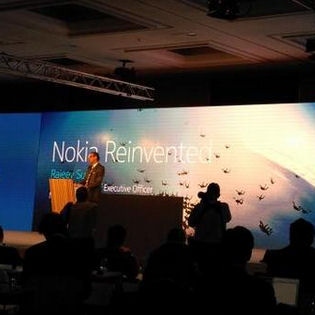Nokia CEO Rajeev Suri put a stop to rumours suggesting it might re-enter the handset business. But speaking in London at the vendor’s first capital markets day in five years, Suri confirmed the Nokia brand is to be re-licensed to appear on other smartphone makers’ devices.
November 17, 2014

Nokia CEO Rajeev Suri put a stop to rumours suggesting it might re-enter the handset business. But speaking in London at the vendor’s first capital markets day in five years, Suri confirmed the Nokia brand is to be re-licensed to appear on other smartphone makers’ devices.
This follows the announcement last month from Microsoft, which bought Nokia’s smartphone business last year, it has decided to drop the Nokia brand ahead of the previously agreed 2016 deadline. Nokia has now devised a new licensing model allowing other vendors to sell their own-manufactured smartphones under the Nokia brand.
“In the brand licensing model it is our goal to start immediately licensing and monetising,” Nokia Technologies President, Ramzi Haidamus said at the event attended by Telecoms.com. “Our goal is that the consumer will not be able to tell the difference between a Nokia built product and a brand licensed product. Occasionally we might come up with something that we want to bring directly to the market, but no such decision has been made as of yet.”
“We have been through some difficult changes, for us and for you,” Suri said. “But we now have the foundation for strong future. As evidence, just look at our performance. We are generating cash, not burning it, producing profits not losses. We have a strong capital structure and gone from a long period of decline to our first quarter of year-on-year growth since 2011.”
The event’s agenda focused Nokia’s current financial state and future outlook in the light of the past years as the company has gone through a turbulent change. The firm unveiled its strategy for its three business units: maps, technology (including brand licencing) and networks.
However, despite being an investor event, Nokia remained cagey on financial predictions. The words of the day seemed to be efficiency, opportunity and growth, but it didn’t become clear exactly how, where and when growth was going to be achieved.
One of the ways in which Nokia said it has endeavoured to stay on top of the game is acquisition. Group CFO Timo Ihamuotila said all acquisitions are fully integrated into the Nokia portfolio. An example of this, as showcased at the event’s demo area, is Nice, an Israeli surveillance tech firm acquired by Nokia last summer and whose technology it now uses to provide customers 3D images of their network performance and traffic trends. The technology assesses connectivity in an area, and the results are then displayed interactively on a screen allowing viewers to zoom in or out.
Other topics touched upon included IoT, especially in the form of Nokia’s navigation solution HERE, SDN (software defined networking), small cells and 5G. “We expect the first pre-standard 5G trials in Korea by 2018 – and we will be there,” Suri said.
Nokia, once the dominant force in mobile, has gone through a spectacular fall from grace. One of the reasons for the fall of Nokia’s star was in the company’s culture, which it stubbornly held on to even when the market started to change, and Nokia should have recognised its position wasn’t set in stone. “We have stumbled in the past. We will not allow that to happen again. We must change [our] culture,” Suri said.
Innovation is apparently one of the areas where Nokia has changed culture, and the vendor also counts this as a key differentiator against its competition. “One of the things I personally have learned is that in order to innovate effectively you need discipline but you also need the right ecosystem,” Nokia Networks EVP and CTO, Hossein Moiin told Telecoms.com.
“In order to create the right ecosystem, there are so many complex parameters and different variables you need to optimise that it won’t be easy to replicate unless you open your company and your research labs to collaborate with outside projects. So to that end I think it’s a unique approach.
“We don’t claim we know all the answers, we are very open to collaborating with partners, customers, universities, government agencies, all sorts of actors in this space so that we can actually solve real world problems.”
The underlying message at the event seemed to be Nokia’s admission of making grave mistakes in the past, but that it has learned from them and the future is looking bright. It is good to see the firm is in a healthier position than in a long while but it remains to be seen how much it has transformed itself.
While the company is doing some good stuff in the networks space, the HERE business faces challenges. Nokia said it isn’t in competition with Google, and it is targeting car manufacturers with HERE, but so are quite a few other players in the market. Once more it remains to be seen how much money is in this market, and the same can be said for the licensing business, but a change in corporate culture is definitely a key step in the right direction.
About the Author(s)
You May Also Like








.png?width=300&auto=webp&quality=80&disable=upscale)


_1.jpg?width=300&auto=webp&quality=80&disable=upscale)


.png?width=800&auto=webp&quality=80&disable=upscale)